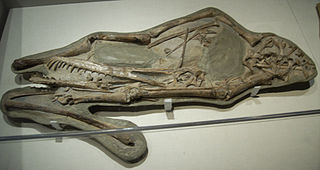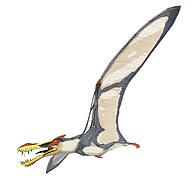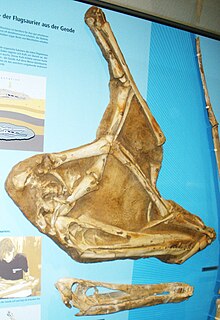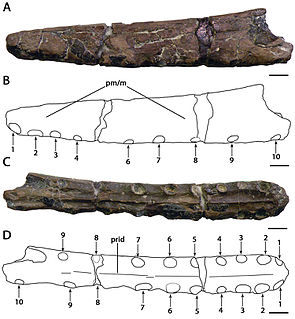
Cearadactylus is a genus of large Early Cretaceous (Albian) pterosaurs from the Romualdo Formation of Brazil, South America. The only known species is Cearadactylus atrox, described and named in 1985 by Giuseppe Leonardi and Guido Borgomanero. The name refers to the Brazilian state Ceará and combines this with Greek daktylos, "finger", a reference to the wing finger of pterosaurs. The Latin atrox means "frightful", a reference to the fearsome dentition of the species.

Ornithocheirus is a pterosaur genus known from fragmentary fossil remains uncovered from sediments in the UK.

Tropeognathus is a genus of large pterosaurs from the late Early Cretaceous of South America. It is a member of the Ornithocheiridae, a group of pterosaurs known for their keel-tipped snouts, and was closely related to species of the genus Anhanguera. The type and only species is Tropeognathus mesembrinus; a second species, Tropeognathus robustus, is now considered to belong to Anhanguera. Fossils of Tropeognathus have been recovered from the fossiliferous Romualdo Formation of the Araripe Basin in northeastern Brazil.

Thalassodromeus is a genus of pterosaur that lived in what is now Brazil during the Early Cretaceous period, about 100 million years ago. The original skull, discovered in 1983 in the Araripe Basin of northeastern Brazil, was collected in several pieces. In 2002, the skull was made the holotype specimen of Thalassodromeus sethi by palaeontologists Alexander Kellner and Diogenes de Almeida Campos. The generic name means "sea runner", and the specific name refers to the Egyptian god Seth due to its crest being supposedly reminiscent of Seth's crown. Other scholars have pointed out that the crest was instead similar to the crown of Amon. A jaw tip was assigned to T. sethi in 2005, became the basis of the new genus Banguela in 2014, and assigned back to Thalassodromeus as the species T. oberlii in 2018. Another species was named in 2015 based on a supposed crest fragment, but this was later shown to be part of a turtle shell.
Anhanguera is a genus of pterodactyloid pterosaur known from the Early Cretaceous Romualdo Formation of Brazil. This pterosaur is closely related to Ornithocheirus, but belongs in the family Anhangueridae. The generic name comes from the tupi words añanga, meaning "spirit protector of the animals" + wera "bygone".
Brasileodactylus a genus of pterosaur from the Aptian, Lower Santana formation of Chapada do Araripe, Ceará, Brazil.

Siroccopteryx is an extinct genus of pterodactyloid pterosaur, known from the middle Cretaceous sediments in Morocco. Some researchers, such as David Unwin, consider the genus a junior synonym of Coloborhynchus.

Coloborhynchus is a genus in the pterosaur family Ornithocheiridae, and is known from the Lower Cretaceous of England, and depending on which species are included, possibly the Albian and Cenomanian ages as well. It is the largest known toothed pterosaur.

Liaoningopterus, sometimes misspelled "Liaoningopteryx", was a genus of anhanguerid pterodactyloid pterosaur from the Barremian-Aptian-age Lower Cretaceous Jiufotang Formation of Chaoyang, Liaoning, China.

Santanadactylus was a genus of pterodactyloid pterosaur from the Albian-age Romualdo Member of the Upper Cretaceous Santana Formation, of Barra do Jardim, Araripe Plateau, Ceará Province, Brazil. Four species have been named, but today are no considered congeneric with each other. It was a rather large pterosaur.

Ornithocheiridae is a group of pterosaurs within the suborder Pterodactyloidea. They were among the last pterosaurs to possess teeth, along with their close relatives, the lonchodectids and targaryendraconians. The ornithocheirids lived from the Early to Late Cretaceous around 140 to 96 million years ago. They were some of the most advanced ornithocheiromorphs.

Uktenadactylus is a genus of pterodactyloid pterosaurs from the Lower Cretaceous Paw Paw Formation of Texas.

Anhangueridae is a group of pterosaurs within the suborder Pterodactyloidea. They were among the last pterosaurs to possess teeth. A recent study discussing the group considered the Anhangueridae to be typified by a premaxillary crest and a lateral expansion in the distal rostrum. The same study presented a cladistic analysis, for which an "agreement subtree" was calculated. The Anhangueridae was found to be sister taxon to the large crested Tropeognathus.
Anhanguera araripensis is a pterosaur species from the Albian-age Romualdo Member of the Early Cretaceous Santana Formation, of Barra do Jardim, Araripe Plateau, Ceará Province, Brazil. A. araripensis was named after the Araripe Plateau.

Maaradactylus spielbergi is a pterosaur species from the Albian-age Romualdo Member of the Lower Cretaceous Santana Formation, of Barra do Jardim, Araripe Plateau, Ceará Province, Brazil. M. spielbergi was named after the filmmaker Steven Spielberg, the director of Jurassic Park.
Anhanguera robustus is a large pterosaur species known from fossil remains dating to the Early Cretaceous Period of South America.

Camposipterus is a genus of pterodactyloid pterosaur from the Cretaceous of England.

Ikrandraco is a genus of pteranodontoid pterosaur known from Lower Cretaceous rocks in northeastern China. It is notable for its unusual skull, which features a crest on the lower jaw.
Maaradactylus is a genus of anhanguerid pterodactyloid pterosaur known from the Lower Cretaceous Romualdo Formation of northeastern Brazil.

Ornithocheiromorpha is a group of pterosaurs within the suborder Pterodactyloidea. Fossil remains of this group date back from the Early to Late Cretaceous periods, around 140 to 94 million years ago. Ornithocheiromorphs were discovered worldwide, except Antarctica, though most genera were recovered in Europe, Asia and South America. They were the most diverse and successful pterosaurs during the Early Cretaceous, but throughout the Late Cretaceous they were replaced by better adapted and more advanced pterosaur species such the pteranodontids and azhdarchoids. The most diverse families of the group, the Ornithocheiridae and Anhangueridae, survived until the early Late Cretaceous with Ferrodraco, Ornithocheirus, Cimoliopterus, Lonchodectes and Lonchodraco being some of the last remaining. The Ornithocheiromorpha was defined in 2014 by Andres and colleagues, and they made Ornithocheiromorpha the most inclusive clade containing Ornithocheirus, but not Pteranodon.














